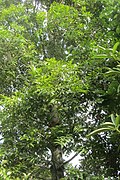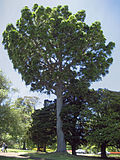Agathis
| Agathis Temporal range:
Paleoceneto recent | |
|---|---|

| |
| Agathis robustaEastern Australia | |
| Scientific classification | |
| Kingdom: | Plantae |
| Clade: | Tracheophytes |
| Clade: | Gymnospermae |
| Division: | Pinophyta |
| Class: | Pinopsida |
| Order: | Araucariales |
| Family: | Araucariaceae |
| Genus: | Agathis Salisb.1807 |
| Type species | |
| Agathis loranthifolia Salisb.1807
| |

| |
| Distribution ofAgathisspecies | |
| Synonyms[1] | |
Agathis,commonly known askauriordammara,is a genus of evergreen coniferous trees, native to Australasia and Southeast Asia. It is one of three extant genera in the familyAraucariaceae,alongsideWollemiaandAraucaria(being more closely related to the former).[1][2]Its leaves are much broader than most conifers.Kauri gumis commercially harvested fromNew Zealand kauri.
Description
[edit]This sectionneeds additional citations forverification.(June 2021) |

Mature kauri trees have characteristically large trunks, with little or no branching below the crown. In contrast, young trees are normally conical in shape, forming a more rounded or irregularly shaped crown as they achieve maturity.[3]
The bark is smooth and light grey to grey-brown, usually peeling into irregular flakes that become thicker on more mature trees. The branch structure is often horizontal or, when larger, ascending. The lowest branches often leave annular branch scars when they detach from the lower trunk.
The juvenile leaves in all species are larger than the adult, more or less acute, varying among the species from ovate to lanceolate. Adult leaves are opposite,ellipticaltolinear,very leathery and quite thick. Young leaves are often a coppery-red, contrasting markedly with the usually green or glaucous-green foliage of the previous season.
The male pollen cones appear usually only on larger trees after seed cones have appeared. The female seed cones usually develop on short lateral branchlets, maturing after two years. They are normally oval or globe shaped.
Seeds of some species are attacked by the caterpillars ofAgathiphaga,some of the most primitive of all living moths.
Uses
[edit]
Various species of kauri give diverse resins such as kauri gum. The timber is generally straight-grained and of fine quality with an exceptional strength-to-weight ratio and rot resistance, making it ideal for yacht hull construction. The wood is commonly used in the manufacture of guitars and ukuleles due to its low density and relatively low price of production. It is also used for some Go boards (goban). The uses of the New Zealand species (A. australis) included shipbuilding, house construction, wood panelling, furniture making, mine braces, and railway sleepers. Due to the hard resin of the wood, it was the traditionally preferred material used byMāorifor wooden weapons,patu aruhe(fernroot beaters) andbarkclothbeaters.[4]
Evolutionary history
[edit]WithinAraucariaceae,Agathisis more closely related toWollemiathan toAraucaria.The oldest fossils currently confidently assignable toAgathisare those ofAgathis immortalisfrom theSalamanca Formationof Patagonia, which dates to thePaleocene,approximately 64.67–63.49 million years ago.Agathis-like leaves are also known from the slightly olderLefipán Formationof the same region, which date to the very end of the Cretaceous.[5]Other fossils of the genus are known from theEoceneof Patagonia, the Late Paleocene-Mioceneof southern Australia, and theOligocene-Miocene of New Zealand.[6]Agathis-like remains are also found in the olderBahariya Formationof Egypt.
Species list
[edit]| Phylogeny ofAgathis[7][8] | |||||||||||||||||||||||||||||||||||||||||||||||||||||||||||||||||||||||||||||||||||||||||||||
|
- Accepted species[1]
| Image | Scientific name | Common Name | Distribution |
|---|---|---|---|
 |
Agathis atropurpurea | black kauri, blue kauri | Queensland,Australia |
 |
Agathis australis | New Zealand kauri | North Island,New Zealand |
 |
Agathis borneensis | Borneo kauri | westernMalesia,Borneo |
 |
Agathis dammara | Sulawesi kauri | Philippines,Sulawesi,Maluku Islands |
| Agathis flavescens | Tahan Agathis | Peninsular Malaysia | |
 |
Agathis kinabaluensis | Kinabalu kauri | Borneo |
| Agathis labillardieri | New Guinea kauri | New Guinea | |
 |
Agathis lanceolata | Koghi kauri | New Caledonia |
| Agathis lenticula | Sabah kauri | Borneo | |
 |
Agathis macrophylla(syn.A. vitiensis) | Pacific kauri, dakua | Fiji,Vanuatu,Solomon Islands |
 |
Agathis microstachya | bull kauri | Queensland, Australia |
| Agathis montana | New Caledonia | ||
 |
Agathis moorei | white kauri | New Caledonia |
| Agathis orbicula | Sarawak kauri | Borneo | |
 |
Agathis ovata | Scrub kauri | New Caledonia |
 |
Agathis robusta | Queensland kauri | Queensland, Australia; Papua New Guinea |
| Agathis robustasubsp.robusta | Queensland and Papua New Guinea | ||
| Agathis robustasubsp.nesophila | New Guinea kauri | Papua New Guinea | |
| Agathis silbae | Vanuatu | ||
| Agathis zamunerae | Patagonia, South America Argentina |
- Formerly included[1]
Moved toNageia
- Agathis motleyi -Nageia motleyi
- Agathis veitchii -Nageia nagi
The placement of the fossil species"Agathis" jurassicafrom the Late Jurassic of Australia in this genus is doubtful.[9]
Gallery
[edit]-
Te Matua Ngahere,anA. australisin Waipoua Forest, the oldest (and 2nd largest) tree in New Zealand
-
Trunk of the Yakas kauri (7th largest)
-
Agathis lanceolata
-
Agathis ovata
-
Agathis macrophylla
-
Agathis robusta
-
Agathis borneensis
-
Agathis australismale pollen cone
-
Scale fromAgathis australisfemale cone
-
Agathis australisleaves and cones
References
[edit]- ^abcdKew World Checklist of Selected Plant Families
- ^de Laubenfels, David J. 1988. Coniferales. P. 337–453 in Flora Malesiana, Series I, Vol. 10. Dordrecht: Kluwer Academic.
- ^Whitmore, T.C. 1977.A first look at Agathis.Tropical Forestry Papers No. 11.University of OxfordCommonwealth Forestry Institute.
- ^Neich, Roger (1996)."New Zealand Maori Barkcloth and Barkcloth Beaters".Records of the Auckland Institute and Museum.33:111–158.ISSN0067-0464.JSTOR42906461.WikidataQ58677501.
- ^Escapa, Ignacio H.; Iglesias, Ari; Wilf, Peter; Catalano, Santiago A.; Caraballo-Ortiz, Marcos A.; Rubén Cúneo, N. (August 2018)."Agathis trees of Patagonia's Cretaceous-Paleogene death landscapes and their evolutionary significance".American Journal of Botany.105(8): 1345–1368.doi:10.1002/ajb2.1127.hdl:11336/87592.ISSN0002-9122.PMID30074620.S2CID51908977.
- ^Wilf, Peter; Escapa, Ignacio H.; Cúneo, N. Rubén; Kooyman, Robert M.; Johnson, Kirk R.; Iglesias, Ari (January 2014)."First South American Agathis (Araucariaceae), Eocene of Patagonia".American Journal of Botany.101(1): 156–179.doi:10.3732/ajb.1300327.hdl:11336/27660.ISSN0002-9122.PMID24418576.
- ^Stull, Gregory W.; Qu, Xiao-Jian; Parins-Fukuchi, Caroline; Yang, Ying-Ying; Yang, Jun-Bo; Yang, Zhi-Yun; Hu, Yi; Ma, Hong; Soltis, Pamela S.; Soltis, Douglas E.; Li, De-Zhu; Smith, Stephen A.; Yi, Ting-Shuang; et al. (2021)."Gene duplications and phylogenomic conflict underlie major pulses of phenotypic evolution in gymnosperms".Nature Plants.7(8): 1015–1025.bioRxiv10.1101/2021.03.13.435279.doi:10.1038/s41477-021-00964-4.PMID34282286.S2CID232282918.
- ^Stull, Gregory W.; et al. (2021)."main.dated.supermatrix.tree.T9.tre".Figshare.doi:10.6084/m9.figshare.14547354.v1.
{{cite journal}}:Cite journal requires|journal=(help) - ^Hill, Robert S. & Brodribb, Tim J. (1999). "Southern Conifers in Time and Space".Australian Journal of Botany.47(5): 639–696.doi:10.1071/BT98093.Cited inDettmann, Mary E. & Clifford, H. Trevor (2005)."Biogeography of Araucariaceae"(PDF).In Dargavel, John (ed.).Araucarian Forests.Kingston, Australia: Australian Forest History Society. pp. 1–9.ISBN978-0-9757906-1-8.Archived from the original on 2018-12-03.Retrieved2021-05-17.
{{citation}}:CS1 maint: bot: original URL status unknown (link)









